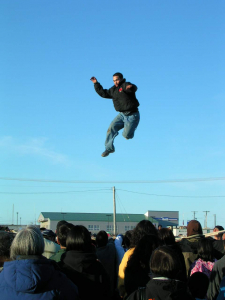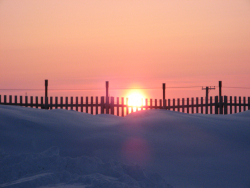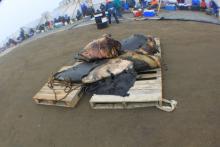What Are They Doing?

Historical ecology is an applied research program that focuses on interactions of people and their environments. Research applications involve studying and understanding this relationship in both time and space to gain a full picture of all of its accumulated effects. The research program can be applied to understanding changes among community landscapes that can assist strategies for the future. For this proposal the emphases align with the ARIES mission that combines research, education, and community outreach.
The emphases are 1) a bibliographic database of relevant historical resources, 2) an examination of the shoreline to provide a time-series baseline 3) simulation models to demonstrate socio-natural cycles of change for the North Slope shoreline, 4) the historical ecology study of the shoreline, interactive mapping and database available as a web based resource to assist academia, industry, regional government and local communities for socio-cultural and management purposes, 5) an integrated team who can work with interested researchers, industry planners and Risk Management of the North Slope Borough to extract data and provide simulation models that apply to current studies of the region and 6) provide a variety of eco-heritage opportunities that include community participation in research, educational products, age level appropriate activities and outreaches for community service learning.
This includes natural and social science research and use of eco-heritage data for disaster preparedness among the "Next Generation", that is, middle and high school students. This aligns with the Cumulative Risk Integrated Operability Project (CRIOS) with DHS CREATE funds, since 2008, to reduce risks across emergency management jurisdictions of tribally inclusive geographic areas (TIGA). Here is the project website.
Where Are They?

The land is vast and remote; and while seemingly rugged, is really remarkably fragile. The ancient cultural traditions practiced today by Iñupiat Eskimos have survived in one of the world's harshest climates through their ability to adapt. They adapted to the discovery of oil in their traditional homeland by forming the North Slope Borough which offers residents a chance to help manage the lands, participate in the benefits of the oil boom at the same time to protect the subsistence values, especially whaling. Learn more about the North Slope of Alaska.
Latest Journals

Anne is interested in applying natural science and social science research to assist community based decision making in the areas of Historical Ecology, Public Archaeology, Museum Education, Culture Contact Studies, Applied Anthropology for Disaster Preparedness and Mitigation. You can see her ARIES website here.

My academic interest are Anthropology, Biology, Public Health, Global Health, Portuguese, Spanish, Italian, and Psychology. My research interests are Disease, Health, Culture, Disaster Management.
I am both a Biology undergraduate at Stony Brook University in New York and a graduate of Biological Anthropology at the University of Maryland at College Park.
My personal interests are Literature, Music, Art, Languages, Technology, Culinary Arts, Conservation, International Aid and Development. My social interests are Theatre, Film, Exploring New Places, and Museums. You can learn more about me at the ARIES Website.



